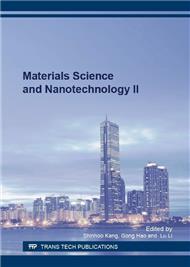[1]
W. Wei, R. Sun, J. Cui and Z. Wei, Removal of nitrobenzene from aqueous solution by adsorption on nanocrystalline hydroxyapatite, Desalination 263 (2010) 89-96.
DOI: 10.1016/j.desal.2010.06.043
Google Scholar
[2]
Y.C. Huang, P.C. Hsiao, and H.J. Chai, Hydroxyapatite extracted from fish scale: Effects on MG63 osteoblast-like cells, Ceramics International, 37 (2011) 1825–1831.
DOI: 10.1016/j.ceramint.2011.01.018
Google Scholar
[3]
S. Kongsri, K. Janpradit, K. Buapa, S. Techawongstienb and S. Chanthai, Nanocrystalline hydroxyapatite from fish scale waste: Preparation, characterization and application for selenium adsorption in aqueous solution, Chemical Engineering Journal, 215-216 (2013).
DOI: 10.1016/j.cej.2012.11.054
Google Scholar
[4]
S. Sankar, S. Sekar, R. Mohan, S. Rani, J. Sundaraseelan and T.P. Sastry, Preparation and partial characterization of collagen sheet from fish (Lates calcarifer) scales, Int. J. Biol. Macromol, 42 (2008) 6-98.
DOI: 10.1016/j.ijbiomac.2007.08.003
Google Scholar
[5]
S. Kupiec and Z. Wzorek, The influence of calcination parameters on free calcium oxide content in natural hydroxyapatite, Ceramics International, 38 (2012) 641-647.
DOI: 10.1016/j.ceramint.2011.06.065
Google Scholar
[6]
R. Rozita, A. Rohana, A.B. Mohamad and M.M. Sam'an, Synthesis and characterisation of pure nanoporous hydroxyapatite, Journal of Physical Science, Penerbit Universiti Sains Malaysia, 22: 1 (2011) 25-37.
Google Scholar
[7]
M.P. Ferraz, F.J. Monteiro, M. Manuel, Hydroxyapatite nanoparticles: A review of preparation methodologies, Journal of Applied Biomaterials & Biomechanics 2004; 2: 74-78.
Google Scholar
[8]
S. Hamzah, N. Ali, M.M. Ariffin, A.W. Mohamad, N. Othman, Adsorption of trypsin onto chitosan/psf affinity membranes: Effects of physio-chemical environment, J. Teknologi Sci. and Eng. 74: 7 (2015) 1-6.
DOI: 10.11113/jt.v74.4686
Google Scholar
[9]
S. Hamzah, N. Ali, A.W. Mohamad, M.M. Ariffin, A. Ali, Design of chitosan/PSf self-assembly membrane to mitigate fouling and enhance performance in trypsin separation, J. Chem. Tech. Biotechnol. 3740 (2012) 1157 - 1160.
DOI: 10.1002/jctb.3740
Google Scholar
[10]
M.S. Shojai, M.T. Khorasani, E.D. Khoshdargi and A. Jamshidi, Synthesis methods for nanosized hydroxyapatite with diverse structures, Acta Biomaterialia. 9 (2013) 7591-7621.
DOI: 10.1016/j.actbio.2013.04.012
Google Scholar
[11]
B.N. Tabrizi, A. Fahami, and R. E. Kahrizsangi, A comparative study of hydroxyapatite nanostructures produced under different milling conditions and thermal treatment of bovine bone, Journal of Industrial and Engineering Chemistry. 20 (2014).
DOI: 10.1016/j.jiec.2013.03.041
Google Scholar
[12]
M.L. Luo, J.Q. Zhao, W. Tang and C.S. Pu, Hydrophilic modification of poly (ether sulfone) ultrafiltration membrane surface by self assembly of TiO2 nanoparticles, Applied Surface Science. 249 (2005) 76-48.
DOI: 10.1016/j.apsusc.2004.11.054
Google Scholar
[13]
S.S. Saravanabhavan and S. Dharmalingam, Fabrication of polysulphone/hydroxyapatite nanofiber composite implant and evaluation of their in vitro bioactivity and biocompatibility towards the post-surgical therapy of gastric cancer, Chemical Engineering Journal. 234 (2013).
DOI: 10.1016/j.cej.2013.08.076
Google Scholar
[14]
S.K. Loghmani, M.F. Rad and T. Shahrabi, Effect of polyethyleneglycol on the electrophoretic deposition of hydroxyapatite nanoparticles in isopropanol, Ceramics International, 39 (2013) 7043-7051.
DOI: 10.1016/j.ceramint.2013.02.043
Google Scholar
[15]
C.P. Dhanalakshmi, L. Vijayalakshmi and V. Narayanan, Synthesis and preliminary characterization of polyethylene glycol (PEG)/hydroxyapatite (HAp) nanocomposite for biomedical applications, International Journal of Physical Sciences. 7: 13 (2012).
DOI: 10.5897/ijps11.1495
Google Scholar
[16]
K. Narsiah and Agarwal, Transmission analysis in ultfiltration of ternary rotien mixture through a hydrophilic membrane. Journal of Membrane Science. 287 (2007) 9-18.
DOI: 10.1016/j.memsci.2006.10.001
Google Scholar
[17]
Arthanareeswaran, G. and Mohan, M. Rajajenthiren, Preparation and performance of poly sulfonated poly (ether ketone) blend ultrafiltration membranes. (Part 1), Application Surface Science. 235 (2009) 8705-8712.
DOI: 10.1016/j.apsusc.2007.04.053
Google Scholar
[18]
S. Ferdous, M.A. Ioannidis and, D.E. Henneke, Effects of temperature, pH, and ionic strength on the adsorption of nanoparticles at liquid–liquid interfaces, J. Nanopart Res. 14: 850 (2012) 1-12.
DOI: 10.1007/s11051-012-0850-4
Google Scholar
[19]
N.A. Medellin-Castillo, R.L. Ramos, E.P. Ortega, R.O. Perez, J.V.F. Cano, and M.S.B. Mendoza, Adsorption capacity of bone char for removing fluoride from water solution. Role of hydroxyapatite content, adsorption mechanism and competing anions, Journal of Industrial and Engineering Chemistry. 20: 6 (2014).
DOI: 10.1016/j.jiec.2013.12.105
Google Scholar



